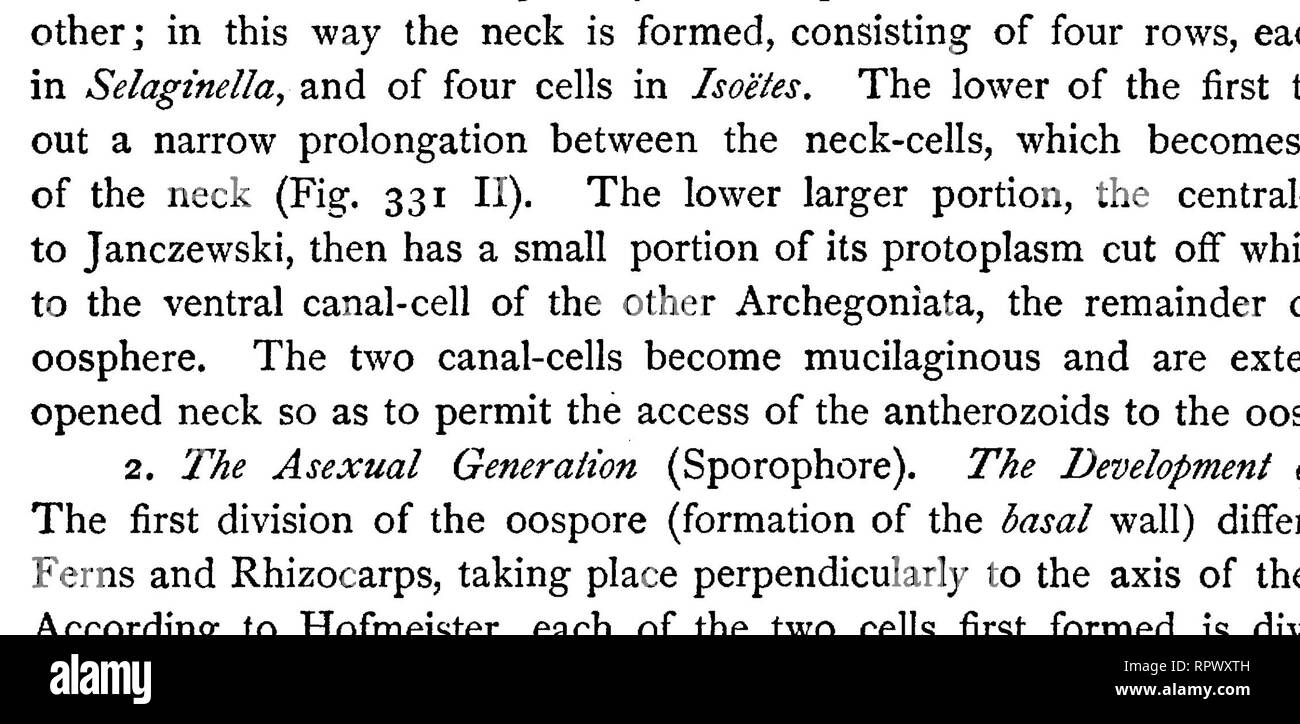. Text-book of botany, morphological and physiological. Botany. FILICINEM. 473 a simple cell; a smaller or larger number of divisions usually takes place in its lower part (Fig. 332, A—D). The embryo itself originates from the lower (epibasal) half of the oospore. By the elongation of the suspensor and the compression and absorption of the surrounding cells, the embryo is forced into the endosperm, in which it now undergoes further development, as in Phanerogams. In the mother- cell of the embryo (epibasal cell) two segments1 are in the meantime formed by the wall II (transverse wall); out of

Image details
Contributor:
Library Book Collection / Alamy Stock PhotoImage ID:
RPWXTHFile size:
7.2 MB (431.7 KB Compressed download)Releases:
Model - no | Property - noDo I need a release?Dimensions:
2263 x 1105 px | 38.3 x 18.7 cm | 15.1 x 7.4 inches | 150dpiMore information:
This image is a public domain image, which means either that copyright has expired in the image or the copyright holder has waived their copyright. Alamy charges you a fee for access to the high resolution copy of the image.
This image could have imperfections as it’s either historical or reportage.
. Text-book of botany, morphological and physiological. Botany. FILICINEM. 473 a simple cell; a smaller or larger number of divisions usually takes place in its lower part (Fig. 332, A—D). The embryo itself originates from the lower (epibasal) half of the oospore. By the elongation of the suspensor and the compression and absorption of the surrounding cells, the embryo is forced into the endosperm, in which it now undergoes further development, as in Phanerogams. In the mother- cell of the embryo (epibasal cell) two segments1 are in the meantime formed by the wall II (transverse wall); out of each proceeds an embryo-leaf (cotyledon), and a longitudinal half of the hypocotyledonary segment of the stem. The foot and root originate besides from the right segment, and in the left (in the figure) segment is formed the two-sided apical cell of the stem (Fig. 332, A, B). While the two segments are becoming transformed by a number of cell-divisions into masses of cells, of which an inner mass very soon separates itself as the procambium of the axial bundle and a peripheral mass as dermatogen and periblem, a swelling is produced laterally beneath the first leaf, forming the foot2; by its increase the. FlG. 332.—Development of the embryo of Selaginella Martensit (after Pfeffer); A, Slower part of the suspensor wtth the first much-divided segments of the embryo, and the apical cell s of the future stem; bb the first leaves; C apical view of the same; D the apex seen from above in the act of forming1 two new apical cells, right and left; /, //, /// the primary walls of the primary apical cell; I'—VII' the longitudinal walls by which the two new apical cells are formed. (/ basal wall; // transverse wall.) stem is forced over to the other side (that of the younger segment); so that the apex comes to lie horizontally, and afterwards is even directed upwards (Fig. 331 /); and finally the bud, with its first leaves, the cotyledons, grows out upright from the apical part of the